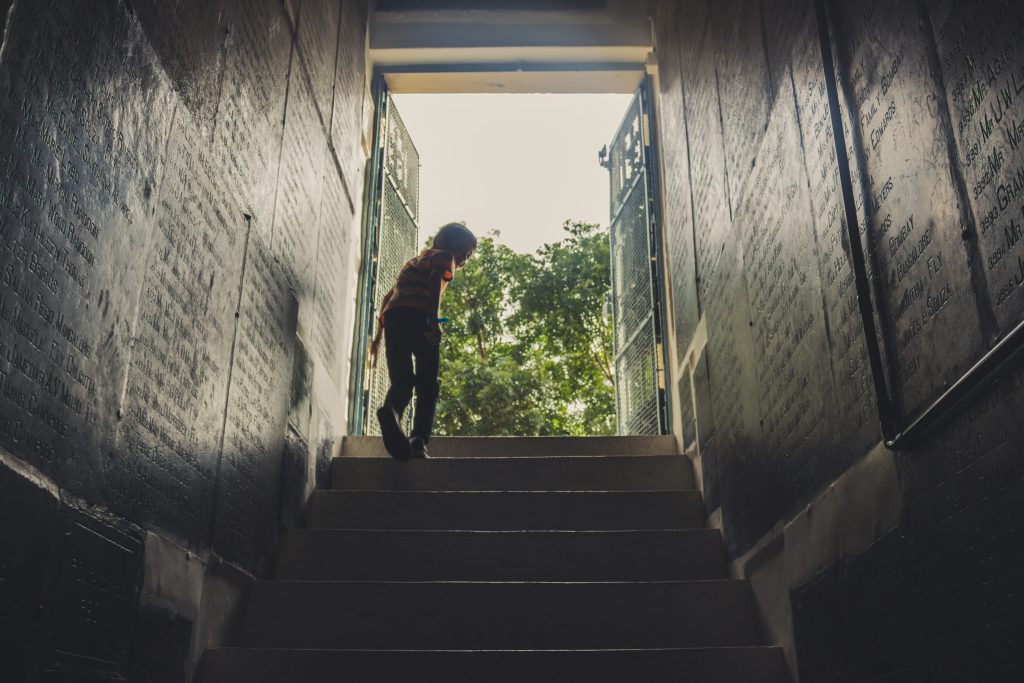There’s a strange kind of silence in abandoned places. It isn’t the peaceful kind—the hush of a quiet morning or the lull of a slow afternoon. No, this silence is thick, layered with the echoes of things long gone. It seeps into the cracked tiles and clings to the dust-coated walls, whispering of a time when everything was still alive.
I’ve always been fascinated by these forgotten spaces, by the eerie beauty of their decay. The way nature begins to reclaim them, vines twisting through broken windows, roots cracking through concrete. The way the past lingers, faint but stubborn, in the yellowed posters curling on the walls, in the overturned chairs and scattered debris that hint at stories we’ll never fully know.
The Mall: A Monument to the Past

The first time I stepped into the idea of the abandoned mall in Morals in the Margin, it wasn’t just a setting. It was a ghost, a hollowed-out monument to something that once mattered. The mall, now emptied of its original purpose, became something more—a vacuum where time folded in on itself, where the past lingered in the air like dust unsettled by an open door. It wasn’t just about broken tiles or graffiti-tagged walls. It was about the silence, the heavy kind that follows after life has moved on, leaving echoes of what once was.
Abandoned malls hold a particular kind of weight. Unlike old houses or forgotten factories, they were never meant to be empty. They were built to be alive—to pulse with the steady hum of voices, footsteps, and music playing over cheap speakers. They were once the center of everything, where people gathered beneath fluorescent lights to kill time, to escape, to belong.
Now, they are still.
Imagine the air is thick with dust, motes swirling in the shafts of light filtering through shattered skylights. The old tile floors are cracked, coated in a thin layer of dirt and dried leaves blown in through shattered glass doors. Storefronts gape open like hollow mouths, their mannequins long removed, their shelves left barren. An old food court, frozen in time, still carries the scent of something artificial—plastic trays, stale popcorn, the ghost of fried food long since cooked and consumed.
A single, overturned chair. A payphone dangling off the hook. An escalator, once moving bodies endlessly up and down, now frozen in place, its metal steps collecting dust. These spaces were designed for movement, yet now they stand still. And that stillness? It makes us uneasy.
The Psychological Pull of Forgotten Places

Why do we find ourselves drawn to places like this? Why do we stop to peer through the shattered windows of an old diner, or feel an inexplicable shiver when stepping into an empty building where the air still carries a faint echo of the past?
Some say it’s nostalgia. A pull toward something familiar but distant, like trying to grasp a memory that isn’t quite yours. Maybe you once walked these halls when they were bright and full of life. Or maybe you didn’t—but the bones of these places still feel known, stitched into the cultural subconscious.
Others believe it’s the thrill of the unknown. The mystery of what remains, of what’s been left behind. Every abandoned place is a story half-finished, a puzzle missing pieces. Who left that soda can perfectly upright on the counter? Who was the last person to lock the doors? What happened just before the lights went out for good?
And then, of course, there’s fear. The kind of fear that sits low in your stomach, warning you that something is off. That fear isn’t about ghosts or monsters—it’s about absence. We fear these places because they remind us of how quickly something vibrant can fade. How the things we believe to be permanent—malls, cities, people—can crumble into nothing but dust and memory.
Urban Exploration and the Beauty of Decay
Urban explorers understand this pull better than most. They seek out these places not to vandalize, but to witness. To document what’s left before time, weather, and indifference consume it completely. Photographers capture the way nature reclaims steel and glass, the way light filters through a broken ceiling, casting fractured patterns across forgotten floors.
There’s something undeniably beautiful about decay. The contrast of man-made structures against the relentless force of time. The soft collapse of wallpaper, curling like old parchment. Rust bleeding into walls. A single plant, its roots pushing through the cracks, a quiet reminder that nothing stays abandoned forever.
A Place Trapped Between Then and Now
In Morals in the Margin, the abandoned mall is more than a backdrop—it’s a breathing, aching thing, a character in its own right. It holds stories, not just of the party unfolding within it, but of the past that still clings to its bones. You can almost hear the distant hum of a forgotten food court, the echo of footfalls that no longer exist. There’s a scent, too—not quite dust, not quite mold, but something in between, something that reminds you that this place was once alive and now exists in a limbo between memory and decay.
The characters step into this world, drawn in by the promise of an exclusive, underground party, but the mall offers them something else entirely. It is the perfect stage for uncertainty, for secrets to fester, for the line between reality and illusion to blur. Inside its hollow corridors, the past and the present tangle together, just as the characters themselves wrestle with their own shifting identities.
Why We Keep Coming Back
There’s a reason we keep telling stories about these places. A reason horror movies love setting their scariest moments in abandoned hospitals and empty malls. This is a reason urban explorers risk trespassing fines just to capture the perfect shot.
Abandoned places remind us that everything fades. But they also remind us that even in emptiness, there’s a strange kind of beauty. A story still waiting to be told.
And maybe that’s why, when we pass an old building with boarded-up windows, we always slow down. Maybe that’s why, even if we don’t step inside, we can’t help but wonder—what’s left in the dark?
If you’re drawn to the eerie beauty of abandoned places, to stories where mystery and memory intertwine, then step into the world of Morals in the Margin. Let the past whisper its secrets, and let the echoes guide you forward. The mall is waiting—are you ready to explore?

